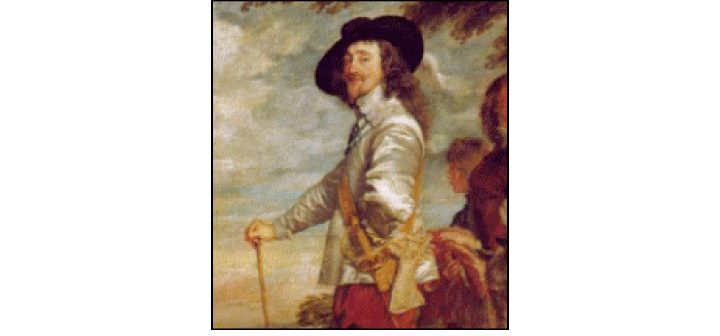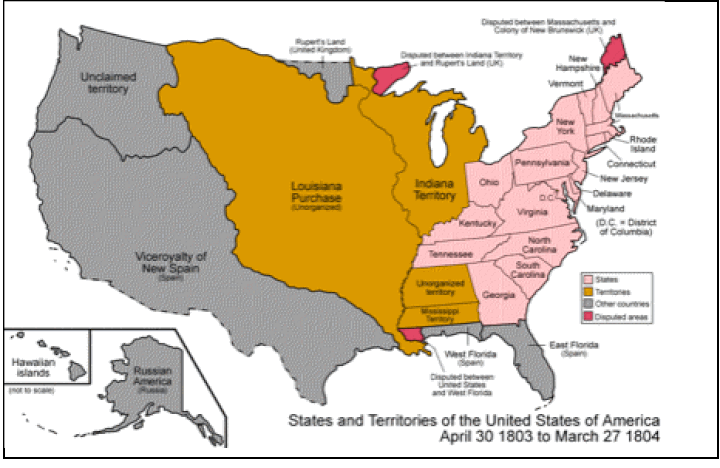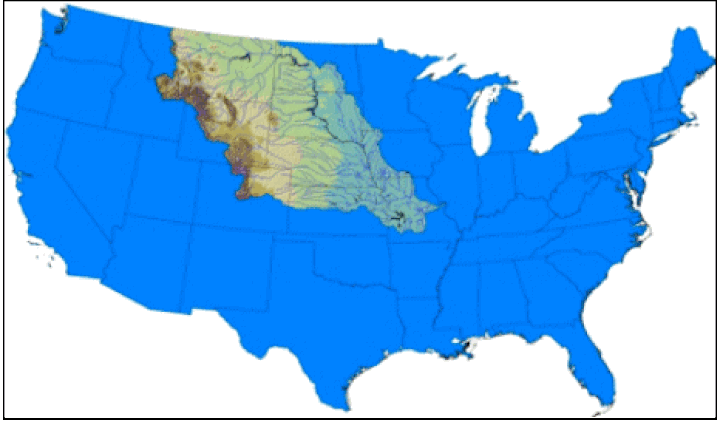The Beaver Boom
Of the Early 1800s
In the American West
By Harold Frost
The History Channel Magazine, 2008
Swedish officers wore wide-brimmed “cavalier” hats made of thick felt, manufactured from beaver fur culled from the streams of Scandinavia and Russia. The hats were durable, shape-holding, and waterproof. They were also expensive, and thus status-affirming.
The Swedish chapeau wasn’t the first beaver headgear of history, but it ranks among the most influential. Many Europeans, including trend-setting royals, took a liking to the Swedish fashion.

King Charles I of England
in a cavalier hat, painted in 1634.
Hatmakers in London, Paris, Berlin, and other cities needed fresh sources of raw materials. They gazed longingly at North America, home of vast numbers of easily-catchable beaver. From the 1600s to the 1800s, the fur business thrived in the New World, starting in New England and spreading west. Designs evolved over the years, arriving in the 19th century at the familiar stove-pipe look associated with Abraham Lincoln and the novels of Charles Dickens.
From the early 1800s to about 1850 the beaver industry boomed in North America. These were years of truly spectacular gleanings and profits. During these years, as the American West opened up, two groups dominated the U.S. beaver business:
* Upper Missouri River traders. The river, meandering across the northern Great Plains (present-day Montana and the Dakotas) was a highway for flinty-eyed white men who, starting in 1807, built log forts, established relations with local Indians, persuaded the natives to trap beaver, exchanged manufactured goods for pelts, and sent bundles of fur by riverboat to St. Louis, and on to the East Coast and Europe.
* Rocky Mountain trappers (the Mountain Men). From the early 1820s to the early 1840s, buckskin-clad young white men trapped beaver in the Rockies – Jim Bridger, Kit Carson, Tom Fitzpatrick, and their ilk. (Some of these trappers were also traders.)
*
The American fur business took tremendous impetus from the Louisiana Purchase, signed in the spring of 1803.

The Louisiana Purchase covered 828,800 square miles.
This purchase was one of the boldest gambles ever made by the U.S.A., akin to the moon program of the 1960s, dramatically expanding the country’s conception of itself. President Thomas Jefferson sent Meriwether Lewis and William Clark up the Missouri River in the summer of 1803, ordering them to investigate many topics, including fur resources. Jefferson knew that a Western fur trade could provide income for the new nation and pave the way for settling of the West.

The Missouri River Basin (in tan and brown), a section of the Louisiana Purchase.
Lewis and Clark returned to St. Louis in September, 1806, with big news about the wealth of the hinterlands. Plenty of beaver were out there, they said, and furthermore, many Indians are eager to exchange pelts for trade goods such as rifles, blankets, and cooking utensils.
A man named Manuel Lisa pricked up his ears. “Lisa was a real visionary of the American fur trade,” says historian James A. Hanson. Ambitious and daring, possessed of a bit of capital, Lisa gathered a team of about 50 men in St. Louis in the spring of 1807, shoved off in keelboats, and traveled upstream.
Following This Main Piece, Two Sidebars.
Also, See Here for a Q-and-A Interview about the
Museum of the Fur Trade in Chadron, Nebraska.

Canoeists today on the Upper Missouri River.
This was the beginning of the Upper Missouri Fur Trade.
In coming years, white men built trading forts in the region. A large fort might house 50 to 100 whites and $100,000 worth of trade merchandise – rifles, finely-woven blankets, brass and copper kettles, thick wads of tobacco, knives with big steel blades, vermilion war paint in little packets from China.
Whites instructed Indians in the subtleties of trapping. The natives went into the wilderness and gathered lush, thick pelts, and each spring and autumn hauled their bundles of beaver and other furs to the forts and bargained. The negotiating might take days. Most of the time, say several historians, natives got fair value for their labor – after all, writes David J. Wishart, they were “not slaves to the fur trade….they were intelligent traders.”
Liquor sapped some of that shrewdness. White men were barred by U.S. law from giving alcohol to Indians, but did so anyway, especially when firms competed with one another for pelts. (Hudson’s Bay Company, the powerful British Canadian enterprise, made forays south of the 49th parallel and freely allowed its employees to ply Indians with booze.) It should be noted, however, that a steady torrent of booze from whites to Indians did not occur to a significant degree during the fur trade period. Not until the 1870s and ’80s did that particular horror unfold.
*
The Upper Missouri region wasn’t the only source for beaver.
Farther west, in the sparkling streams of the Rocky Mountains, in places like Jackson Hole and Yellowstone, large numbers of beaver industriously felled trees and built their lodges and dams, blissfully unaware of what was about to happen to them.
The Indians of the Rocky Mountains were willing to trade a few pelts for manufactured goods, but white entrepreneurs wanted lots of fur. How, asked businessman William H. Ashley in the early 1820s, can we obtain the immense wealth waiting for us in the high country? His answer: White men should do the trapping.
Thus was born the Mountain Man.
Ashley assembled a team of about 100 men in St. Louis in 1822 and headed up the Missouri bound for the Rockies. This was the first sizable group of Mountain Men. For the next 20 years or so, about 1,000 of these brave and hardy souls trapped beaver in the Rockies and shipped fur back to civilization.
Mountain Men usually traveled in small teams called brigades. (A few elite trappers worked alone.) Tramping along the banks of rivers and streams, hacking through thick wet underbrush, negotiating uncharted terrain, occasionally getting attacked by Indians, the men sought their grail – beaver lodges and dams. They put out traps at sunset and raised them in the morning, generally finding drowned beaver caught in the cold, dripping steel. The men skinned and processed the night’s catch and proceeded apace.

Robert Redford plays a Mountain Man
in the 1972 film “Jeremiah Johnson.”
Mountain Men worked hard in the spring and autumn and took their ease in the winter, living in cabins in sheltered valleys, oiling their traps, repairing their clothing, conversing around fires, drinking frontier whiskey, and eating buffalo steaks (“the greatest meat man has ever fed on,” reports author Bernard DeVoto). If fresh buffalo wasn’t available, they consumed pemmican, based on dried buffalo, which, if prepared well, is “the best of all concentrated foods,” writes DeVoto, “a splendid high-energy food, a complete diet in itself.”
In summer, Mountain Men gathered in sun-dappled valleys for their “rendezvous.” (A meadow near present-day Daniel, Wyoming, was a frequent site.) Here, trappers and Indians sold furs, feasted, drank liquor from St. Louis, gambled, fought, raced horses, danced wild jigs to fiddle music, sparked romance with native women, and howled at the moon.
Bernard DeVoto finds in the Mountain Men “an extremity, perhaps the maximum, of American individualism and gusto.” He notes that they responded deeply, poetically, to the loveliness of the country, and found in their way of life “something precious beyond safety, gain, comfort, and family life” – i.e., freedom and truly fresh air and water. (More on DeVoto here.)
Mountain Men helped shape America’s self-image. Theodore Roosevelt’s influential history of the West, written in the late 1800s, adores these intrepid souls. (Roosevelt had himself photographed in Mountain Man buckskin regalia.) Several Hollywood movies depict them, including “How the West Was Won” (1962) and “Jeremiah Johnson” (1972).
The Mountain Man Era ended in the early 1840s when beaver supplies played out. Business at the trading forts also declined. Silk hats replaced now-scarce beaver on the market. By the late 1850s the global fur trade was pretty much over.
*
Many current scholars of the North American West find disturbing themes in the Mountain Men and in the fur business overall. Trappers and traders, writes David J. Wishart, exerted “great pressure on the environment….with relative impunity.” This behavior was “destructive to the physical environment and to the native inhabitants alike” and set an unfortunate template for settlement of the West. Historian Gordon S. Wood sums up one aspect of the expansionist policies of Thomas Jefferson: “deadly for the native Indians in the West.”
This “dark lens,” in Wishart’s phrase, is a new element affecting our view of how the West was won. It needs to be taken into account even as we honor the gusto. ●
By Harold Frost
The most powerful fur baron of American history was John Jacob Astor (1763-1848), “America’s first multimillionaire,” in the phrase of biographer Axel Madsen.
Born in southern Germany, the son of a butcher, Astor arrived penniless in the U.S. in 1784. He was short, strong, reserved, and disciplined. He wanted money.
His entrée into the fur business came when he found a job in New York City beating beaver pelts with a stick to disperse moths and their eggs. Soon thereafter he began haunting East River docks buying a spare pelt or two, which he carted downtown and sold for a profit. With these modest earnings he relocated to upstate New York, bought beaver skins from trappers, and sent them by riverboat to New York, where they were loaded on vessels bound for Liverpool and London. His capital accumulated.
In 1799, with a net worth of $100,000, Astor began buying Manhattan property. His real estate legacy lives on today in such entities as the Waldorf-Astoria Hotel in Manhattan (and its affiliates around the country) and the Astoria section of Queens.
He expanded his fur empire ruthlessly, taking advantage of the unregulated economy of the day. By 1817 his American Fur Company had cornered the trade in the Great Lakes region, and in the 1820s the company dominated the Upper Missouri. It also moved aggressively into the Rocky Mountains. “It maintained its monopoly,” notes the “Columbia Encyclopedia,” “by the customary early practice of buying out or crushing any small company that threatened opposition.” Zachary Taylor, a military man and 12th President of the United States, knew Astor’s frontier employees well, and regarded them as “the greatest scoundrels the world ever knew.”
Astor sold his fur holdings in 1834, anticipating the trade’s decline. At the time of his death in 1848 he was the wealthiest man in America. His great-grandson, financier John Jacob Astor (1864-1912), died with the sinking of the Titanic.
By Harold Frost
Bernard DeVoto won a Pulitzer Prize for his 1947 book “Across the Wide Missouri,” a massive, insightful study of Mountain Men. But the book’s treatment of Native Americans is problematic, according to some contemporary scholars, including Theodore (Ted) Binnema, 44, an associate professor at the University of Northern British Columbia, one of the best of the younger generation of historians studying the North American West.
For example, DeVoto finds little that’s good in the Blackfoot people (also known as Niitsitapiksi), characterizing them as “the most teutonic of Plains Indians…ferocious” – mainly interested, it seems, in attacking white fur trappers and traders, while, by contrast, more peaceable Flatheads are “superior Indians.”
“Superior” is a loaded word, Binnema says, that says more about DeVoto’s cultural values than about native groups.
Indeed, says Binnema, DeVoto’s descriptions of Indians are frequently stereotypical, lacking in necessary subtlety. “It’s inaccurate,” he says, “to characterize a complex aboriginal society with rigid formulas – with such simplistic terms as, ‘Well, this is the way they were, this is how they thought about whites, they were teutonic, and that’s all we need to know, end of story.'” Where DeVoto sees the Blackfeet as a monolithic entity, Binnema sees a community riven with factions, endlessly debating what to do about the whites. Where DeVoto sees mindless bloodlust, Binnema perceives rational, careful, clear-eyed calculations of foreign policy with regard to encroachers. Where DeVoto sees constant Blackfoot aggression, Binnema sees an exaggeration of Blackfoot violence by contemporary witnesses because of confusion about what tribe was involved. “Many ‘Blackfeet’ attacks,” Binnema writes in a scholarly article, “especially south of the Missouri River Basin, were actually mounted by Gros Ventre warriors – not Niitsitapiksi at all.”
New thinking about the Blackfeet is an example of how historians constantly revise views of the past, standing on the shoulders of the scholars who preceded them, using new sources, and re-interpreting old ones. A key source for Binnema is the microfilmed archive of Hudson’s Bay Company, stored in Winnipeg, a massive collection that, if stacked as paper, would rise for almost two miles. DeVoto never saw this material; it only became available to historians in the 1970s. Binnema has also been influenced by the New Indian History that began emerging in the late 1960s and early ’70s. ●
